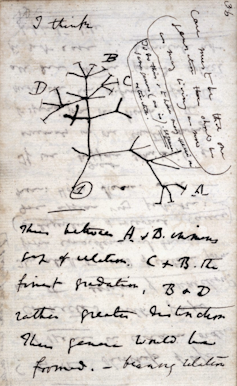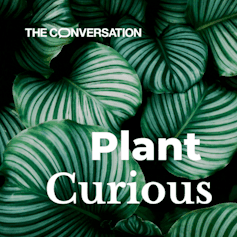If you looked up 66 million years ago you might have seen, for a split second, a bright light as a mountain-sized asteroid burned through the atmosphere and smashed into Earth. It was springtime and the literal end of an era, the Mesozoic.
If you somehow survived the initial impact, you would have witnessed the devastation that followed. Raging firestorms, megatsunamis, and a nuclear winter lasting months to years. The 180-million-year reign of non-avian dinosaurs was over in the blink of an eye, as well as at least 75% of the species who shared the planet with them.
Following this event, known as the Cretaceous-Paleogene mass extinction (K-Pg), a new dawn emerged for Earth. Ecosystems bounced back, but the life inhabiting them was different.
Many iconic pre-K-Pg species can only be seen in a museum. The formidable Tyrannosaurus rex, the Velociraptor, and the winged dragons of the Quetzalcoatlus genus could not survive the asteroid and are confined to deep history. But if you take a walk outside and smell the roses, you will be in the presence of ancient lineages that blossomed in the ashes of K-Pg.
Many people think of plants as nice-looking greens. Essential for clean air, yes, but simple organisms. A step change in research is shaking up the way scientists think about plants: they are far more complex and more like us than you might imagine. This blossoming field of science is too delightful to do it justice in one or two stories.
This article is part of a series, Plant Curious, exploring scientific studies that challenge the way you view plantlife.
Although the living species of roses are not the same ones that shared Earth with Tyrannosaurus rex, their lineage (family Rosaceae) originated tens of millions of years before the asteroid struck.
And the roses are an not unusual angiosperm (flowering plant) lineage in this regard. Fossils and genetic analysis suggest that the vast majority of angiosperm families originated before the asteroid.
Ancestors of the ornamental orchid, magnolia and passionflower families, grass and potato families, the medicinal daisy family, and the herbal mint family all shared Earth with the dinosaurs. In fact, the explosive evolution of angiosperms into the roughly 290,000 species today may have been facilitated by K-Pg.
Angiosperms seemed to have taken advantage of the fresh start, similar to the early members of our own lineage, the mammals.

PopTika/Shutterstock
However, it’s not clear how they did it. Angiosperms, so fragile compared with dinosaurs, cannot fly or run to escape harsh conditions. They rely on sunlight for their existence, which was blotted out.
What do we know?
Fossils in different regions tell different versions of events. It is clear there was high angiosperm turnover (species loss and resurgence) in the Amazon when the asteroid hit, and a decline in plant-eating insects in North America which suggests a loss of food plants. But other regions, such as Patagonia, show no pattern.
A study in 2015 analysing angiosperm fossils of 257 genera (families typically contain multiple genera) found K-Pg had little effect on extinction rates. But this result is difficult to generalise across the 13,000 angiosperm genera.
My colleague Santiago Ramírez-Barahona, from the Universidad Nacional Autónoma de México, and I took a new approach to solving this confusion in a study we recently published in Biology Letters. We analysed large angiosperm family trees, which previous work mapped from mutations in DNA sequences from 33,000-73,000 species.
This way of tree-thinking has laid the groundwork for major insights about the evolution of life, since the first family tree was scribbled by Charles Darwin.

Although the family trees we analysed did not include extinct species, their shape contains clues about how extinction rates changed through time, through the way the branching rate ebbs and flows.
The extinction rate of a lineage, in this case angiosperms, can be estimated using mathematical models. The one we used compared ancestor age with estimates for how many species should be appearing in a family tree according to what we know about the evolution process.
It also compared the number of species in a family tree with estimates of how long it takes for a new species to evolve. This gives us a net diversification rate – how fast new species are appearing, adjusted for the number of species that have disappeared from the lineage.
The model generates time bands, such as a million years, to show how extinction rate varies through time. And the model allowed us to identify time periods that had high extinction rates. It can also suggest times in which major shifts in species creation and diversification have occurred as well as when there may have been a mass extinction event. It shows how well the DNA evidence supports these findings too.
We found that extinction rates seem to have been remarkably constant over the last 140-240 million years. This finding highlights how resilient angiosperms have been over hundreds of millions of years.
We cannot ignore the fossil evidence showing that many angiosperm species did disappear around K-Pg, with some locations hit harder than others. But, as our study seems to confirm, the lineages (families and orders) to which species belonged carried on undisturbed, creating life on Earth as we know it.
This is different to how non-avian dinosaurs fared, who disappeared in their entirety: their entire branch was pruned.
Scientists believe angiosperm resilience to the K-Pg mass extinction (why only leaves and branchlets of the angiosperm tree were pruned) may be explained by their ability to adapt. For example, their evolution of new seed-dispersal and pollination mechanisms.
They can also duplicate their entire genome (all of the DNA instructions in an organism) which provides a second copy of every single gene on which selection can act, potentially leading to new forms and greater diversity.
The sixth mass extinction event we currently face may follow a similar trajectory. A worrying number of angiosperm species are already threatened with extinction, and their demise will probably lead to the end of life as we know it.
It’s true angiosperms may blossom again from a stock of diverse survivors – and they may outlive us.




